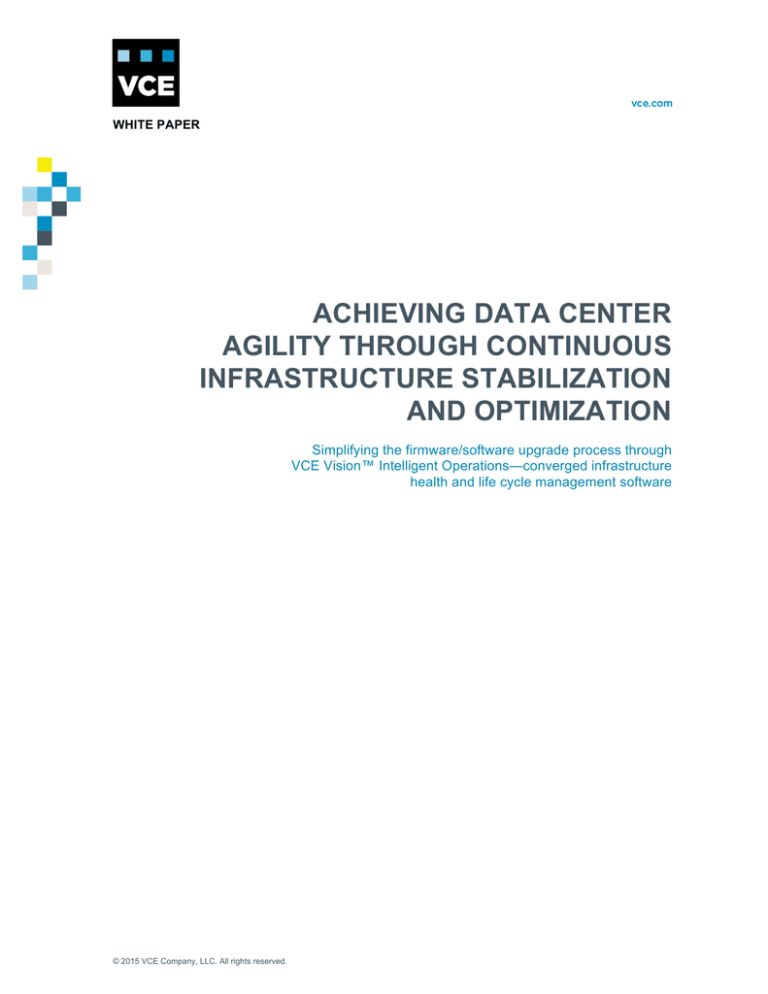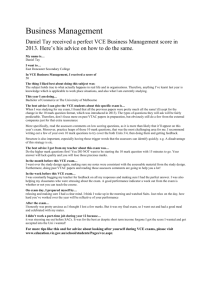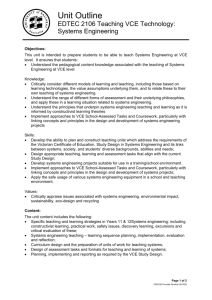
vce.com
WHITE PAPER
ACHIEVING DATA CENTER
AGILITY THROUGH CONTINUOUS
INFRASTRUCTURE STABILIZATION
AND OPTIMIZATION
Simplifying the firmware/software upgrade process through
VCE Vision™ Intelligent Operations—converged infrastructure
health and life cycle management software
© 2015 VCE Company, LLC. All rights reserved.
Table of Contents
The Demand for Data Center Agility and a Continuous
Infrastructure Upgrade Process ........................................................................ 3
Understanding the Challenge and Solution for Stabilizing
and Optimizing Converged Infrastructure ........................................................ 4
Drawbacks of Reference Architecture and Do-It-Yourself Integration and
Upgrade Processes ......................................................................................................................... 4
Assurance of the VCE Vision™ Intelligent Operations and the VCE Release
Certification Matrix Process ............................................................................................................. 4
Eliminating the Burden of Converged Infrastructure
Interoperability Testing and Validation ............................................................. 6
VCE Engineering Innovation and Dedication Enable Converged Infrastructure
System Sustainability ...................................................................................................................... 6
Quantifying the Required Interoperability Testing Investment......................................................... 8
The Expanding Horizon of Converged Infrastructure
Life Cycle Management ...................................................................................... 9
Broader Aspects of Compliance ...................................................................................................... 9
Ongoing Innovation for Multisystem Management and Sustainability ........................................... 10
Next Steps.......................................................................................................... 10
© 2015 VCE Company, LLC. All rights reserved.
2
The Demand for Data Center Agility and a Continuous Infrastructure
Upgrade Process
The demand for data center agility has never been greater. As the technology industry transitions from secondplatform to third-platform solutions, IT organizations are under tremendous pressure to manage an exploding
volume of workloads and deliver exponentially more business value to the enterprise through a host of new
applications.
Your company’s enterprise resource planning (ERP), customer relationship management (CRM), and online
transaction processing (OLTP) applications are generating enormous amounts of data. To be competitive, you
need a way to harness information collected about business operations, customers, consumption patterns, and
product preferences—and serve customers as never before, using innovative web-scale applications that
effectively leverage big data, mobile, social, and private and hybrid cloud technologies.
Meeting the challenges of this rapidly changing IT environment requires data center infrastructure with the
flexibility to scale up or out quickly and efficiently—with exceptional reliability and without burdening your staff.
Increasingly, integrated (i.e., converged) systems are enterprises’ preferred solution to address these
1
challenges. In June 2014, VCE was named a leader in the Gartner Magic Quadrant for Integrated Systems.
VCE delivers advanced converged infrastructure solutions using best-of-breed multivendor compute, storage,
network, and virtualization components that are engineered, integrated, and manufactured for optimal
performance and availability. The solution’s family of systems targets a variety workload demands and together
provides a modular grow-as-needed architectural design and on-demand resource-sharing for agility.
Keeping your data center agile requires that infrastructure remains stable and optimized throughout its life cycle.
To assure this, you must regularly upgrade your infrastructure with component vendors’ firmware and software
releases that deliver the most current innovations for improved performance, new capabilities, and critical bug
fixes.
But after initial deployment of new, converged infrastructure, you may ask yourself, “How can I regularly optimize
and stabilize infrastructure when firmware upgrades are so time-consuming, require maintenance windows that
take systems offline, and risk outages due to incompatibilities?” Most organizations cannot afford the required
interoperability testing to assure that upgrades will not result in outages or devote the time it takes to troubleshoot
exactly which upgrade caused a given outage—and then roll back unsuccessful upgrades.
VCE Vision™ Intelligent Operations, software embedded in VCE converged infrastructure systems, has the
intelligence and automation to dramatically improve operations staff productivity for this important aspect of
converged infrastructure life cycle management. Drawing upon the results of VCE continuous and comprehensive
multivendor firmware/software interoperability testing, VCE Vision™ software tells you which converged
infrastructure components need to be upgraded and then automates many time-consuming steps of the upgrade
process. This frees your staff to handle more value-added tasks and keeps your data center at the highest levels
of stability and optimization, while mitigating the risk of upgrade-induced outages.
1
“Gartner Magic Quadrant for Integrated Systems,” Gartner, June 16 2014. Gartner does not endorse any vendor, product or services depicted in its
research publications and does not advise technology users to select only those vendors with the highest ratings or other designation, Gartner
Research publications consist of opinions of Gartner’s research and should not be construed as statements of fact. Gartner disclaims all warranties,
expressed or implied, with respect to this research, including any warranties of merchantability or fitness for a particular purpose.
© 2015 VCE Company, LLC. All rights reserved.
3
Understanding the Challenge and Solution for Stabilizing and Optimizing
Converged Infrastructure
Drawbacks of Reference Architectures and Do-It-Yourself Integration and Upgrade Processes
Enterprises that rely on a reference architecture (RA) to build their converged infrastructure systems commonly
work from a multivendor component hardware compatibility list (HCL) compiled by RA solution vendors. Typically,
these vendors test interoperability of the individual elements that comprise the converged system: multivendor
server blades, storage controllers and disks, network switches, virtual machine hypervisors, and so on. An HCL
sets forth the compatibility of various infrastructure elements based on their firmware and software versions, so
you, the end user, can deploy the elements together as an infrastructure stack.
But these HCLs typically rely on tests of just a handful of behaviors that predict how the components may
interact with one another, and the results are generally only tested and validated for your initial build of the stack.
As a result, the HCL information you receive is not comprehensive enough to reflect the various states and wide
variety of conditions under which the compute, storage, network, and virtualization components may be employed
over time.
HCLs are also not well sustained by RA vendors throughout the infrastructure life cycle. So, when hardware
and software updates become available from component (i.e., server, storage, network, hypervisor) vendors,
the interoperability testing of the updates is left undone. This leaves you at the greatest risk of an incompatibility
failure that could take your system offline and require up to hundreds of man-hours to resolve.
One solution, of course, would be for you to conduct a comprehensive range of tests. But as you’ll see in the
following discussion, this would require you to maintain an army of dedicated systems and quality assurance
engineers, and make significant investments in non-production, state-of-the-art laboratory testing equipment to
provide a comprehensive, safe level of assurance.
Assurance of VCE Vision Intelligent Operations and the VCE Release Certification Matrix Process
VCE addresses the need for ongoing data center agility by maintaining a release certification matrix (RCM) for
VCE converged infrastructure systems throughout their life cycle. Adherence to the RCM helps assure that
VCE converged infrastructure systems will maintain stability and consistently perform at an optimized level as
expected throughout their life cycle. VCE Vision software draws upon VCE monthly RCM addenda and biannual
comprehensive RCM updates to enable regular infrastructure upgrade interoperability and compliance. The twiceyearly major RCM releases are ideal for customers that want to update everything at once—with intermediate
addenda made available whenever a patch may be required to fix a component performance or functionality issue
and to address a security concern that scores highly on the common vulnerabilities and exposures (CVE) scale.
Unique to VCE, the RCM contains a regularly updated, authoritative listing of interoperable software and firmware
versions for compute, storage, network, and virtualization components that have been tested and certified for use
within fully integrated VCE converged infrastructure systems. VCE Vision software intelligence incorporates RCMs
as digital profiles used to detect drift of firmware and software versions currently installed on VCE converged
infrastructure systems from the expected versions (i.e., from the current RCM) and to identify which versions
require upgrading (i.e., listed on the next RCM).
VCE Vision software automation facilitates the downloading of firmware/software releases for prepositioning,
provides you the guidance for installing them in the proper order, and then validates completion of the upgrades.
This automates what otherwise would be a time-consuming, exceptionally costly, and error-prone manual process
for ensuring that the right versions of software and firmware are always running within your environment.
© 2015 VCE Company, LLC. All rights reserved.
4
Figure 1: Intelligence and Automation to Simplify Infrastructure Life Cycle Management Processes: VCE Vision
software drives repeatable operational processes for planning and applying regular technology upgrades while mitigating
their potential risk. The software automates key phases (shown in green) of the infrastructure firmware/software upgrade
process and guides you to safely apply upgrades manually in the proper order, without having to take the system offline.
Figure on the left illustrates a periodic full system upgrade. Figure on the right illustrates a periodic check to assure that
firmware/software release levels resident on the system have not drifted out of compliance. (See Figure 3 for details of
each step).
VCE Vision software automated compliance-checking works in conjunction with the VCE Vision™ System Library,
which discovers and maintains an object model of VCE converged infrastructure systems. To ensure up-to-date
models, the object model is rediscovered every 15 minutes. Models include a physical device and virtual
environment inventory and firmware-software release levels:
! Compute engine (e.g., chassis, fabric extenders, fabric interconnects, blade servers)
! Storage (e.g., control station, disk array enclosure, data mover, disks)
! Network devices (e.g., processors, memory, ports)
! Virtual environment (e.g., hypervisor)
The object model also includes the state of the system’s components that VCE Vision software intelligence and
automation use for architecture-aware health monitoring—a unique capability among converged infrastructure and
IT monitoring tool vendors. (See the “VCE Vision™ Intelligent Operations Software for Converged Infrastructure”
white paper.)
VCE Vision software is integrated with popular third-party IT management tools. This lets your operations
staff conduct the firmware/software compliance audit and upgrade process through these tools’ familiar user
interfaces to:
! Schedule and automate recurring RCM compliance scans (i.e., audits) to detect drift from expected
release versions
! Schedule and automate periodic scans for planned upgrades to full system enhancements
! Run ad hoc scans based on VCE technical and security alerts (derived from component vendors’ ad hoc
software patches to fix bugs and address vulnerabilities)
These three procedures give you exceptional control and a clear audit trail for complying with your business’
governance polices as well as industry and regulatory policies.
© 2015 VCE Company, LLC. All rights reserved.
5
Figure 2: Evaluating and Reporting Compliance to the Best-Known State of Infrastructure: VCE Vision software
enriches popular third-party IT management tools with the controls to schedule, run, and report firmware/software
compliance tests. Reports validate a converged infrastructure system’s compliance to the best-known state of
infrastructure stability and optimization (i.e., the target Release Certification Matrix). This detects drift from expected
firmware/software releases, provides details for taking corrective actions across all technology components that comprise
the converged infrastructure system, and pinpoints which components require upgrades based on upcoming RCMs.
Eliminating the Burden of Converged Infrastructure Interoperability Testing
and Validation
VCE Engineering Innovation and Dedication Enable Converged Infrastructure System Sustainability
Let’s examine the challenge of not relying on VCE to test and validate upgrades for your infrastructure. Without
VCE Vision software and the Release Certification Matrix (RCM), your organization would need to duplicate what
VCE’s dedicated engineering group does—with its hundreds of highly trained component-specific, system-design
and quality-assurance engineers—to build and maintain the RCM. This requires an overwhelming amount of time,
effort, and cost for any enterprise or service provider IT organization to bear. Yet VCE is able to amortize this
expense across its hundreds of customers to make it affordable. And this contributes to VCE Systems’ excellent
2
return on investment (ROI) reported by VCE customers , including:
! 41 percent less IT time spent keeping the lights on
! 4.4X faster time-to-market for services/products
! 4.6X more applications developed/delivered per year
! 96 percent less downtime
The VCE team’s responsibility is to validate the interoperability of every converged infrastructure component
(compute, storage, network, and virtualization) and for every relevant firmware/software release and patch issued
by component vendors. This includes extensive logical and physical tests to:
! Run base regression tests to verify each existing component’s interoperability
! Create tests for any new functionality
2
IDC white paper, sponsored by VCE, “The Business Value of VCE Vblock Systems: Leveraging Convergence to Drive Business Agility,” April 2015
© 2015 VCE Company, LLC. All rights reserved.
6
! Conduct integration tests that include all the individual components, including “smart” cabinets
! Assess the interoperability of any adjunct systems, such as data protection
Interoperability testing covers components directly interfacing with each other, components that are part of an
edge interface (e.g., two “hops” or more from the device under test), and components that are in a functional line
that could come into play as part of a particular process.
In addition to firmware upgrades and software patches for hardware, testing includes virtualization software
upgrades. Typically, new releases of VMware vSphere virtualization software include driver support for every
blade server, storage, and network component designed to work within a VCE converged infrastructure
environment. But without the VCE RCM, you would need specialists for all those components and an expensive
battery of tests to validate the enormous number of interoperability scenarios and their permutations.
Figure 3: Automation Assists IT Operations in Life Cycle Management Processes: VCE Vision software leverages
VCE engineering’s ongoing publication of the Release Certification Matrix (RCM) as an inspection template for all VCE
converged infrastructure systems. The software automates key steps, including inspections, throughout the process of
sustaining (i.e., stabilizing and optimizing) data centers. This enables more frequent upgrades to data centers—while
mitigating risks associated with other upgrade methods—and frees your operations staff to focus on more value-added
projects.
Another critical issue that you should be aware of is how the infrastructure testing is conducted. For some
infrastructure vendors, the objective is simply to get a system to pass. VCE believes that it is essential to test for
failures—to understand precisely how and why an infrastructure system failed. VCE engineers want to learn all
they can so they can better predict how a system might behave when specific issues arise. This information is
then used to create an RCM that truly provides the assurance that VCE converged infrastructure systems will
continue to operate under almost any condition and in any situation.
© 2015 VCE Company, LLC. All rights reserved.
7
Quantifying the Required Interoperability Testing Investment
How many hours of testing are required to produce an RCM? For example, the flagship of the VCE converged
®
infrastructure systems is the Vblock System 700 series. That series is built with more than 30 multivendor
components whose firmware releases—including multiple drivers—must be individually checked, not to mention
®
all of the platform subsystems that must also be tested. These tests add up quickly. For the Vblock System 740,
VCE will conduct at least 356 tests and review a minimum of 600 test cases, with the work requiring between 160
and 320 hours.
Hundreds of hours of additional testing is required to validate that new firmware/software release upgrades will be
compatible with any firmware/software on existing systems that will be retained (e.g., see if new hypervisor and
server release upgrades validated for compatibility between themselves will also interoperate with a system’s
current storage and network releases that will be retained).
Figure 4: Continuous Effort to Assure Firmware and Software Interoperability: Understanding the known good state
of converged infrastructure is based on gold standards, such as the most current set of firmware and software releases
from component manufacturers. VCE makes significant investments in interoperability and upgrade testing to assure that
an upgrade or patch does not result in a service outage or degradation. This perpetual VCE process results in the VCE
Release Certification Matrix, the gold standard for converged infrastructure life cycle management.
VCE also tests interoperability for ad hoc software patches issued by vendors to fix bugs and to address security
vulnerabilities. This level of testing assures that a would-be corrective action to your converged systems will not
result in an unintended service outage.
Keep in mind that this testing is conducted for all members of the expanding VCE Vscale™ Architecture—adding
up to thousands of hours of effort that go into each biannual RCM update per system. And the testing is repeated
on an ongoing basis—month after month, year after year—as each technology component vendor ships its
updated firmware and software packs for VCE converged infrastructure systems. Supporting all of this is VCE
investment in labs and specialized testing equipment worth millions of dollars.
As part of this process, VCE reviews recommendations for the content of RCM releases from a variety of parties:
the component manufacturers that are supplying firmware/software upgrades and patches, and VCE Product
Engineering, Product Management, Quality Assurance, Services, and Support Teams.
Every VCE RCM release is specific, clearly defined, fully tested and approved for all software and firmware
upgrades. The VCE Upgrade Guides prescribe the optimal processes for upgrading and enhancing each
particular VCE converged infrastructure system, so you can concentrate less on system sustainability and more
on responding to IT service requests and delivering innovations that provide additional value for your business.
© 2015 VCE Company, LLC. All rights reserved.
8
Figure 5: Firmware Prepositioning and Installation Guidance: VCE Vision software automation validates, which
components in VCE converged infrastructure systems require firmware/software upgrades based on the latest Release
Certification Matrix (RCM). The VCE download center gives you the required firmware/software content packs, relieving
you from tediously searching component vendors’ websites for the upgrades. After you download and preposition the
packs on your local server, VCE Vision software also guides you to install the upgrades in the correct order without
requiring you to take your converged infrastructure systems offline.
The Expanding Horizon of Converged Infrastructure Life Cycle
Management
Broader Aspects of Compliance
Manual methods of assuring compliance to your organization’s security policy are both impractical and dangerous:
just consider the immediacy of security threats, the number of potential points of vulnerabilities in a single
converged infrastructure system’s layers of components and subsystems. This grows exponentially with the scale
of multisystem data centers.
To address this challenge, VCE Vision software applies its intelligence and automation to assess and verify the
security posture of VCE converged infrastructure systems. This includes automating infrastructure inspection for
vulnerabilities based on security alerts from compute, storage, network, and virtualization component vendors.
Using those alerts, VCE Vision software validates which components are vulnerable so you can quickly close
security gaps according to component vendors’ advice. When available, VCE Vision automation provides you with
component vendors’ security software patches and firmware—and will pretest and prevalidate them for
interoperability with all components in VCE Systems prior to releasing them to you.
VCE is continuously developing new, innovative functionality for VCE Vision software based upon customer input
and infrastructure evolution. This includes VCE plans to develop an add-on module for managing capacity from
the perspective of a single VCE converged infrastructure system, a VCE multisystem domain, or your entire data
center. Applying scorecards and compliance principles used in firmware/software and security compliance to
capacity management is another important aspect of assuring data center agility.
© 2015 VCE Company, LLC. All rights reserved.
9
VCE Vision software Compliance Policy Designer is a tool that allows you to customize your policy profiles for
auditing. This enables you to manage routine compliance checking according to the specific parameters that are
applicable to your operational and governance best practices. It can greatly reduce the time and effort your
operations team spends on monitoring and sustaining your data center—freeing them to extend their value to your
business.
Ongoing Innovation for Multisystem Management and Sustainability
VCE pioneered converged infrastructure to deliver operational simplicity and life cycle assurance that helps
transform IT practices to a higher level of IT maturity. Through continuous innovation, the company has also
redefined the category of “converged infrastructure” with the scale-up and scale-out, modular, grow-as-needed
TM
VCE Vscale Architecture. VCE Vision software provides the foundation for a growing array of intelligent and
automated functions to improve IT operational processes, including a unified view of VCE Vscale-based data
centers and hybrid cloud environments for life cycle and health management.
VCE Vision software 3.0 extends its visibility, intelligence, and automation for each individual VCE converged
infrastructure system to unified management of multiple VCE Systems. This multisystem perspective makes it
much simpler and more efficient for your operations team to manage a fast-growing, rapidly changing IT
environment—enabling automatic and highly proactive converged operations data center-wide.
Next Steps
To learn more about VCE Vision software, contact a VCE representative or visit vce.com.
ABOUT VCE
VCE, an EMC Federation Company, is the world market leader in converged infrastructure and converged
solutions. VCE accelerates the adoption of converged infrastructure and cloud-based computing models that
reduce IT costs while improving time to market. VCE delivers the industry's only fully integrated and
virtualized cloud infrastructure systems, allowing customers to focus on business innovation instead of
integrating, validating, and managing IT infrastructure. VCE solutions are available through an extensive
partner network, and cover horizontal applications, vertical industry offerings, and application development
environments, allowing customers to focus on business innovation instead of integrating, validating, and
managing IT infrastructure.
For more information, go to vce.com.
Copyright © 2015 VCE Company, LLC. All rights reserved. VCE, VCE Vision, VCE Vscale, Vblock, VxBlock, VxRack, and the VCE logo are registered
trademarks or trademarks of VCE Company LLC. All other trademarks used herein are the property of their respective owners.
© 2015 VCE Company, LLC. All rights reserved.
06122015
10





